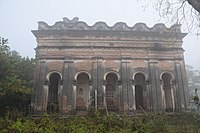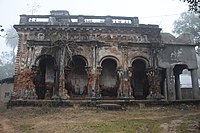Panchrol | |
|---|---|
Village | |
| Coordinates: 21°49′59″N 87°27′10″E / 21.8331°N 87.4527°E | |
| Country | |
| State | West Bengal |
| District | Purba Medinipur |
| Population (2011) | |
• Total | 5,615 |
| Languages | |
| • Official | Bengali, English |
| Time zone | UTC+5:30 (IST) |
| PIN | 721447 |
| Telephone/STD code | 03229 |
| Lok Sabha constituency | Midnapore |
| Vidhan Sabha constituency | Egra |
| Website | purbamedinipur |
Panchrol is a village and a gram panchayat in the Egra I CD block in the Egra subdivision of the Purba Medinipur district in the state of West Bengal, India.
History
[edit]In the Egra copper plate inscription recovered at Panchrol, it is mentioned that Ekatakaksha was an administrative centre during the rule of Shashanka.[1]
Geography
[edit]
5miles
M: municipal city/ town, CT: census town, R: rural/ urban centre, H: historical/ religious centre.
Owing to space constraints in the small map, the actual locations in a larger map may vary slightly
Location
[edit]Panchrol is located at 21°49′59″N 87°27′10″E / 21.8331°N 87.4527°E.
Urbanisation
[edit]96.96% of the population of Egra subdivision live in the rural areas. Only 3.04% of the population live in the urban areas, and that is the lowest proportion of urban population amongst the four subdivisions in Purba Medinipur district.[2]
Note: The map alongside presents some of the notable locations in the subdivision. All places marked in the map are linked in the larger full screen map.
Demographics
[edit]According to the 2011 Census of India, Panchrol had a total population of 5,615, of which 2913 (52%) were males and 2,702 (48%) were females. There were 543 persons in the age range of 0–6 years. The total number of literate persons in Panchrol was 4,425 (87.24% of the population over 6 years).[3]
Culture
[edit]David J. McCutchion mentions:[4]
- The Sharabhuja temple as a large Chandni or dalan type with verandah on three or more sides, measuring 27’ 3" x 42’ 9", with terracotta and stucco work, belonging to the mid-19th century.
- The Madana Mohana temple belongs to the same category, measuring 24’ 3" x 39’ 7", largely plain, belonging to the mid-19th century.
- The Vrindavanjiu temple belongs to the same category, measuring 24’ 3" x 25" 3", with terracotta and stucco work, built in 1909.
- The Radha Vinoda temple is flat-roofed with smooth rekha superstructure, measuring 25" x 35’ 2", with rich stucco work, built possibly in 1816. The upper rekha deul has a porch with cornice and straight ridging.
Panchrol picture gallery
[edit]-
Radha Binoda temple
-
Radha Binoda temple
-
Sharabhuja Gauranga temple
-
Sharabhuja Gauranga temple
-
Terracotta relief at Gauranga temple
-
Terracotta relief at Gauranga temple
-
Madan Mohan temple
-
Madan Mohan temple
Healthcare
[edit]There is a primary health centre at Kasabagola, PO Panchrol (with 2 beds).[5]
References
[edit]- ^ "The Lost Capitals and Places". Ekatakaksha. Dandabhukti. Retrieved 15 August 2020.
- ^ "District Statistical Handbook 2014 Purba Medinipur". Table 2.2. Department of Planning and Statistics, Government of West Bengal. Retrieved 15 August 2020.
- ^ "CD block Wise Primary Census Abstract Data(PCA)". West Bengal – District-wise CD blocks. Registrar General and Census, India. Retrieved 15 August 2020.
- ^ McCutchion, David J., Late Mediaeval Temples of Bengal, first published 1972, reprinted 2017, pages 65, 66. The Asiatic Society, Kolkata, ISBN 978-93-81574-65-2
- ^ "Health & Family Welfare Department". Health Statistics. Government of West Bengal. Retrieved 15 August 2020.










